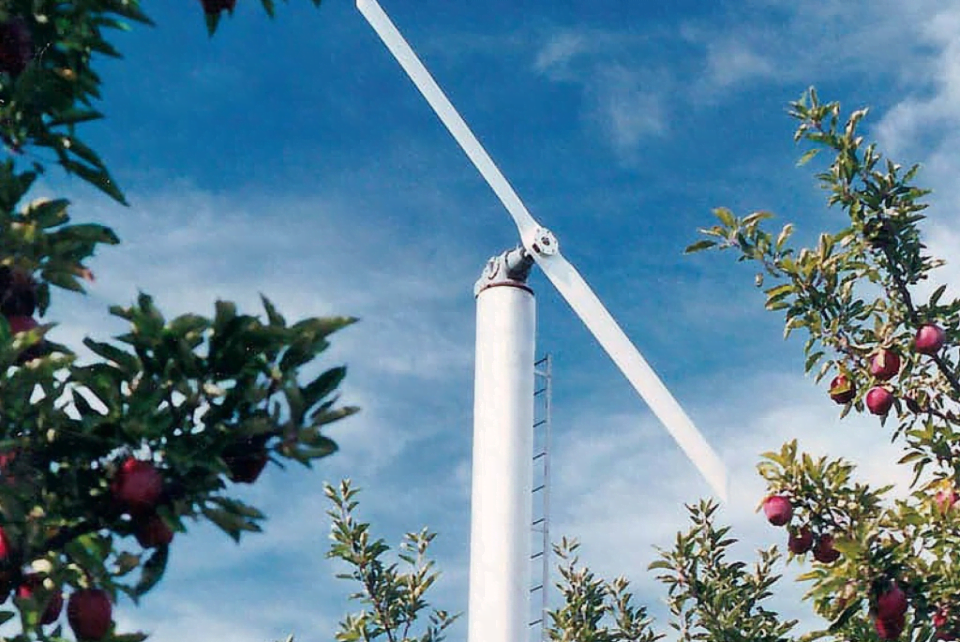According to EastFruit, the accelerating pace of climate change in recent years has the greatest impact on the fruit and vegetable industry, resulting in multibillion-dollar losses for fruit growers and winegrowers. Naturally, farmers do not want to put up with this, so they are increasingly looking for ways to reduce climate risks, and often find them.
“Fruit growing is the most sensitive to climate change segment of agribusiness. Any deviations in temperature from the norm during the year lead to a decrease in yield or quality of fruits, and sometimes to the loss of trees and shrubs. The greatest danger for fruit growers and winegrowers in Europe, and other parts of the world, is spring frosts – in just a few hours, a frost can wipe out all efforts and deprive a grower of his annual income. Even abnormally low temperatures in winter and too high temperatures in summer can cause serious damage to farmers growing fruits, berries, grapes and nuts. Early frosts in autumn often cause significant damage, too. Studying the global experience of protection from the negative impact of weather on horticulture and viticulture, we found that the USA and New Zealand are the leaders in this segment, while a smaller percentage of farms in the EU are protected from climatic anomalies,” explains Andriy Yarmak, economist at the Investment Centre of the Food and Agriculture Organization of the United Nations (FAO).
The main ways to protect orchards, vineyards and berries from frost, according to EastFruit, are:
- Over-plant sprinkler irrigation (also called ice shell) is perhaps the most effective way to protect against frost, although this method, like others, has a number of serious limitations, which we will consider below.
- Under-tree sprinkler irrigation is similar to the first method, but less effective.
- Irrigation or flooding is an even less effective way to protect orchards from frost.
- Smoke is one of the most ancient frost protection methods, but is nevertheless very time-consuming, costly and limited in efficiency.
- Heating orchard is an ineffective and dangerous old method of frost protection.
- Wind machines are a versatile frost protection method that can also be used to cool the orchard during critically high summer temperatures.
- Growing under cover – obviously, this is the best way to protect against frost, but investment in it is much higher than the actual investment in the orchard or berry field itself, so we will not consider this method in this material.
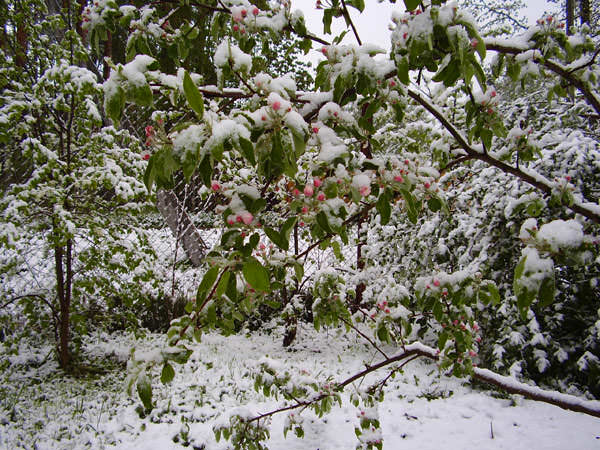
Frost types and their influence on the choice of protection method
Not everyone knows that frosts are different. The bad news is that many basic defenses are almost powerless against one of the two main types of frost, advection frost.
Advective frosts are usually accompanied by rather strong winds and clouds and can persist for quite a long time, which often negates protection efforts. Cloudiness also prevents the air and soil from warming up in the daytime and leads to the absence of temperature inversion. These frosts are the most damaging to lowland orchards because cold air accumulates and is held here longer.
Accordingly, it is difficult to find a mean of protection from this type of frost. Perhaps the only relatively effective method will be over-plaant irrigation, but there are many limitations and nuances here, and most producers cannot apply this method. But more on that below.
Radiative frosts are caused by the cooling of the soil due to effective radiation and are most often observed at night in clear and calm weather. At this time, the effective radiation of the earth’s surface is high, and the turbulence is low, which makes it difficult to mix the cooling subsurface air layer with warmer, higher layers. This type of frost is quite common in the climatic zone of Eastern Europe and Central Asia. It is much easier for farmers to deal with this type of frost, and the effort is usually more effective. In this case, many methods with varying degrees of success can be applied.
Important points to understand the effectiveness of frost control
A healthy orchard, berry plantation or vineyard always tolerates frosts better than a weakened one. Therefore, frost protection starts with strict adherence to all basic agricultural practices, from planting an orchard to caring for it. The absence of diseases and pests, balanced nutrition, correct placement of the orchard, windbreaks – all elements have a direct impact on how much of the crop will be preserved when critical temperatures come.
It is necessary to remember about the reasonable selection of varieties and rootstocks when growing fruits, berries, nuts and grapes. Farmers in our region often buy seedlings in warmer countries, which either do not tolerate low temperatures in winter, or bloom too early, being affected by the waves of spring frosts.
Placing the orchard, berry field or vineyard near a large reservoir always allows to partially protect the farm from minor frosts or reduce damage from lower temperatures.
What type of frost protection should I choose? The main limitations when choosing a method of frost protection in the farm.
The efficiency of over-plant irrigation (or ice shell) is quite high. Moreover, it can be used in the case of advective frosts. In some cases, growers keep the plants safe even at -9 degrees Celsius, using this method of protection. Due to the fact that the flowers, ovary and leaves are covered with a crust of ice, the temperature inside the crust is kept at a level close to zero. This means that there is no freezing and formation of ice crystals inside plant cells, which damage leaves and plants.
Unfortunately, only a few farms will be able to use it. And that’s why:
- The main problem is that a fruit grower or winegrower needs huge reserves of unfrozen water, which must be poured all the time as long as the air temperature remains near zero or below zero.
- In addition, you must initially plan a much more expensive water supply system to use this method: more powerful and expensive pumps, pipes, etc.
- A grower must have a high trellis, which is quite expensive and is used only in intensive orchards.
- Sprinklers for this frost protection method are much more expensive than conventional ones, as plastic sprinklers will not be able to withstand low temperatures.
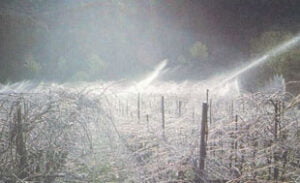
The same restrictions, except for a high trellis, are also relevant for under-tree sprinkler irrigation. However, this method is much less effective.
Irrigation or even flooding the orchard can help protect the orchard, mainly from short-term radiative frosts, but only at temperatures no lower than 2-3 degrees Celsius. Even regular flooding before frost will help reduce damage by increasing humidity and temperature.
However, even here you need to have quite large reserves of water that, especially in spring, many farmers do not have. Likewise, it is better to have a powerful irrigation system in order to quickly pour out significant volume of water.
Smoke is an ancient, expensive and not the most effective method of protection. The smoke spreads through the farm, steeping the trees, and its temperature is higher than the air temperature. In addition, smoke prevents soil from giving off heat, keeping it in the orchard. Here are the main reasons why this method of frost protection can be used only in extreme cases and only in small orchards:
- Many workers are needed, even at night;
- Large stocks of combustible materials (usually slightly rotten straw) or of smoke pellets are needed;
- The method is quite expensive in terms of cost;
- Cannot be used near built-up areas, because smoke damages public health;
- Not effective for advection frosts, because the wind blows away the smoke quickly.
The advantages of the smoke method are no special investments in equipment needed and protection can be deployed quite quickly, if you have everything you need.
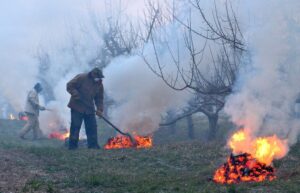
Heating method, i.e. burning various types of fuel to raise the temperature, and not to generate smoke. It is completely ineffective from all points of view: costly, requiring huge labor resources, fire hazard and can even damage or completely destroy a farm or vineyard.
This method allows you to get beautiful photographs of an orchard or vineyard at night under numerous lights, but this is hardly an advantage. It is usually used by growers on the most valuable varieties of grapes, only because they use the cuttings of vines of which they have many.
Wind machines are perhaps the most affordable and universally applicable frost protection method that can be used anywhere. Moreover, wind machines can be useful for farmers and winegrowers and to reduce the air temperature in the orchard in summer. The point is in mixing the upper inversion layer of warm air with colder air in the orchard.
By combining wind machines with heat guns, the effectiveness of this method approaches that of the above-plant irrigation.
However, this method has its drawbacks:
- It is usually not effective in advective frosts, if there are strong wind and cloudiness – cloudiness prevents the formation of an inversion layer of air, and when the wind is higher than 7-8 km/h, the wind machines are turned off for safety reasons;
- It is better to place wind machines no closer than 120-150 meters from residential buildings. The farther they are placed, the better, since they usually work at night and create noise that can disturb local residents.
- Another disadvantage of wind machines can be considered temporary – the demand for wind machines greatly exceeds their supply now. In the EU countries and New Zealand, most of the leading suppliers no longer accept orders until 2023, because their factories are operating at full capacity.
However, the advantages of wind machines far outweigh their disadvantages. Here they are:
- They can be installed in any farm, berry or vineyard and do not depend on any infrastructure, in contrast to the system of above-plant irrigation;
- Fast installation (the protection system can be installed in a matter of days), unlike the irrigation system;
- Investment per hectare is lower compared to above-plant irrigation;
- It can be used not only for frost protection, but also for cooling the orchard during high air temperatures in summer;
- The possibility of using a wind machines to protect against autumn frosts and extend the season for the sale of some crops, the fruiting of which stops with the first frost;
- Ease of system maintenance;
- Durability – usually manufacturers claim 10 years of operation, however, wind machines can be used much longer, as practice shows.
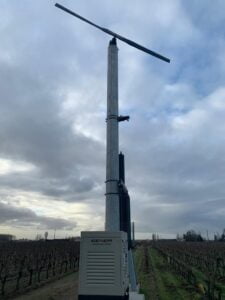
Does the investment in frost protection systems pay off, and if so, how quickly?
We will analyze only effective frost protection measures that require investment: i.e. over-plant irrigation and wind machines.
Both types of frost protection pay off in the very first year of frosts. In other words, they will not pay off only if the grower or winegrower never encounters abnormal weather conditions during the period of use.
Why does the investment in frost protection return in the first year of frosts? Farmers who invest in frost protection equipment are in the minority. Frosts sharply reduce both production volumes and product quality. Therefore, there is a sharp decrease in the supply of high-quality fruit and berry products, which leads to a sharp increase in prices.
This means growers that have invested in frost protection systems will receive a high yield of quality products, and they can even increase income compared to a normal year without frost. As it has already happened many times with apples, blueberries, raspberries, nuts, and other fruit crops, prices often rise by 1.5 to 2 times. Thus, growers with a frost protection system can double their income in such years!
So, we need to see how often frosts occur in our region.
In most regions of Ukraine and Moldova, there were 2-3 cases of frost that caused damage to farmers over the past 5 years. In most regions of Uzbekistan, Tajikistan and Georgia, frosts have occurred 1-2 times over the past 5 years.
We will not manage to list here all the cases of frost in our region in recent years. In 2021, Uzbekistan suffered huge damage from frost, where a large part of the harvest of apricots and other stone fruit crops was lost. By the way, they even touched upon the problem of the local apple harvest. A similar situation was in Tajikistan, where mainly the earliest, most expensive varieties of apricot and cherry were affected, which also led to an increase in prices for dried fruits. In 2020, several waves of frosts in Ukraine destroyed a large part of the blueberry harvest, and sharply reduced the apple harvest. A similar situation arose in 2019 (for two years in a row), when the apple harvest in Ukraine was extremely low due to frost losses. Moldova harvested one of the lowest apple harvests in 2020, partly due to frosts. Both Ukraine and Moldova annually lose a huge percentage of stone fruit and berry harvest due to spring frosts.
In other words, producers installing frost protection systems will be able to repay them in Ukraine and Moldova in 1.5-2.5 years, and in Uzbekistan, Tajikistan or Georgia in 3-5 years.
Additional benefits of frost protection systems for the horticultural business
“In modern business, the quality of fruit and vegetable products and the reliability of their supplies is extremely important. Many large growers or cooperatives of fruits, nuts, berries and grapes producers have contracts for the sale of 70-80% of the expected production a year before the harvest. Accordingly, a frost protection system gives the producer additional advantages in the eyes of the buyer (supermarket chain or importer), because he knows that contracting with such a farmer has a lower risk level. Likewise, a bank lending to an agrarian will also pay attention to the grower’s desire to reduce the risk level of his business and will be inclined to offer cheaper credit resources – and this is a direct savings,” adds Andriy Yarmak, FAO economist.
One cannot discount such a factor as reputation. If a producer provides its counterparties with quality products even in difficult climatic conditions, while competitors do not succeed, his reputation in the eyes of buyers grows.
It is high time to think about reducing the risk levels of business for farmers of Ukraine, Uzbekistan, Moldova, Georgia, Tajikistan and other countries of the region, annually losing tens and even hundreds of thousands of tonnes of cherries, apples, blueberries, nuts, grapes, apricots and other products. After all, it is very profitable and provides excellent long-term benefits amid growing competition in the market.
Efficient frost protection systems will be presented during the 17th international conference “Fruits and Vegetables of Ukraine-2021. New Investment Opportunities” to be held on December 2-3, 2021 in Kyiv (Ukraine). Register to participate via the link not to miss the event.
The use of the site materials is free if there is a direct and open for search engines hyperlink to a specific publication of the East-Fruit.com website.




